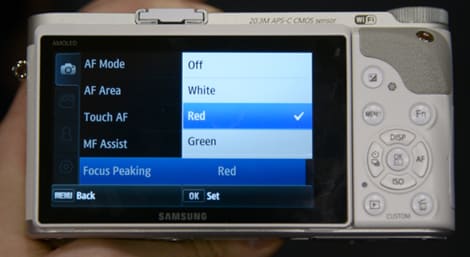Pros
Cons
Introduction
Nikon's Coolpix P500 offered an amazing 36x optical zoom when it debuted last year, pushing the ultrazoom category farther than any other camera before it. Today at CP+ 2012 in Japan, we got our hands on the new Coolpix P510, which succeeds the P500 in the only way it really could: that's right, even more zoom.
The P510 extends optical zoom magnification all the way out to a whopping 42x, that's a 35mm-equivalent focal length of 1,000mm! We only hope image quality doesn't suffer as a result.
This camera will be available immediately, in either red or black, for $429.95.
Design & Appearance
{{section_header}}{{section.name}}{{/section_header}}
The P510's chassis is more angular than most ultrazooms in years past, though this does seem to be the trend for 2012. The body is also smaller than average, which makes the fully extended lens barrel all the more impressive...though maybe a bit silly in our opinion.
In the end there are few physical differences here from the P500, but our floor model did show off the attractive new glossy red finish, which actually seemed to resist fingerprints pretty well.
Tour
{{section_header}}{{section.name}}{{/section_header}}




Menu
{{section_header}}{{section.name}}{{/section_header}}
Beyond the physical buttons, other controls and options are accessible in the menu system, which--design wise--is unchanged from the P500. Thankfully the P500's directional pad has been replaced with a rotating dial, so navigation of the menu system is a bit easier this time around.
Organization is straightforward, if a little too much so. The overpopulated Camera Options tab requires some extra scrolling, but we suppose that's better than wondering which tab contains the option you're looking for.
Ease of Use
{{section_header}}{{section.name}}{{/section_header}}
For the most part buttons are laid out in an intuitive and easy to understand way, with only some minor tweaking since the P500. The movie button is no longer surrounded by a manual video mode switch, and that's fine, we felt this feature was redundant anyway. There's also a new Fn button behind the shutter release, and this can be used to quickly adjust image size, picture control, white balance, metering, continuous shooting, ISO, or AF area mode.


Size & Handling
{{section_header}}{{section.name}}{{/section_header}}
The camera is painless to hold and balance in one hand, but the grip itself is narrow, so those with larger hands may feel a bit cramped. The knurled and rubberized grip is great, just like last year's, and the rear rubber thumb rest is also the same. With the battery inserted, the P510 weighs a little over one pound.


Modes Overview
{{section_header}}{{section.name}}{{/section_header}}
The P510 is capable of full "PASM" shooting, and also features a fully automatic green mode, custom mode, and a few dedicated effects and scene modes.

Auto Mode
{{section_header}}{{section.name}}{{/section_header}}

Movie Mode
{{section_header}}{{section.name}}{{/section_header}}
1080p video shooting is possible at 30 frames per second, and there are a variety of lower resolution options available as well, including 720p and iFrame formats. All videos are recorded in H.264 encoding.
Drive/Burst Mode
{{section_header}}{{section.name}}{{/section_header}}
Maximum burst mode shooting speed is 7 frames per second for five shots in a row. This is a slight step down from the P500, but that's to be expected due to the P510's extra resolution. High speed video shooting at up to 120 frames per second will also be supported, though this will severely limit resolution.
Custom Image Presets
{{section_header}}{{section.name}}{{/section_header}}
Like the P500, the P510 includes a fully customizable User mode for storing your favorite presets. This feature gets its own real estate on the mode dial.
Picture Quality & Size Options
{{section_header}}{{section.name}}{{/section_header}}
Maximum image size is 4608 x 3456 pixels, unfortunately no RAW shooting capability is supported.
Focus
{{section_header}}{{section.name}}{{/section_header}}
The P510 uses contrast detection autofocus, and can be set to 9-area automatic, center, face priority, manual area, or subject tracking modes. At the widest focal length, focus lock can be achieved with subjects as close as 1 foot 8 inches away, though a special macro focus mode may be used for subjects as close as 0.4 inches away.
Exposure & Metering
{{section_header}}{{section.name}}{{/section_header}}
Matrix or center-weighted metering modes are available, with spot mode noticeably absent, and flexible program shift is available from the Program shooting mode. Aperture range is a fairly narrow f/3.3-5.9, and shutter speed ranges between a fairly average 4 - 1/2000th seconds.
ISO
{{section_header}}{{section.name}}{{/section_header}}
Maximum ISO sensitivity is 3200, however the P510 also supports a High ISO mode that's equivalent to 6400. Auto mode selects between ISO 100 and 1600, while two varieties of Fixed Range Auto selects between ranges of either 100-400 or 100-800.
White Balance
{{section_header}}{{section.name}}{{/section_header}}
In addition to custom and automatic white balance, the P510 ships with 5 presets: Cloudy, Daylight, Flash, Fluorescent, and Incandescent. Direct color temperature entry in Kelvin is not possible.
Image Stabilization
{{section_header}}{{section.name}}{{/section_header}}
To combat the tendency for ultrazoom cameras to produce blurry shots at the longest focal length, the P510 is equipped with lens-shift vibration reduction. If the technology functions as well as it did in this camera's predecessor, performance should be excellent.
Other Controls
{{section_header}}{{section.name}}{{/section_header}}
3D Photography
A 3D Photography setting is one brand new addition this year, however it's buried in the Scene Modes so many users may never find it.
Panorama Assist
Painless panorama shooting makes a return for this model, but once again the feature is buried in the Scene Modes, where some users may not think to look.
Lens & Sensor
{{section_header}}{{section.name}}{{/section_header}}
At the heart of this camera is a 16.1 megapixel CMOS sensor, an upgrade from the P500's 12.1 megapixel unit. The giant lens barrel extends to a maximum focal length of 180mm, and sticks out rather amusingly from the rest of the body while shooting with full magnification. 42x is the most optical zoom we've ever seen from a fixed lens.

LCD & Viewfinder
{{section_header}}{{section.name}}{{/section_header}}
The 3.0-inch LCD monitor is a fixed position panel with 5 brightness settings and an anti-reflective coating. The screen's resolution is 921,000-dots, exactly the same as the P500's.

This camera also features an electronic viewfinder with 100% coverage and diopter adjustment.

Flash
{{section_header}}{{section.name}}{{/section_header}}
The P510's flash is exactly the same as the P500's, with an identical performance rating (maximum range of 26 feet) and positioning at the top of the body.

Jacks, Ports & Plugs
{{section_header}}{{section.name}}{{/section_header}}
Two I/O terminals are located underneath a rubber cover on the right panel of the body. There's a standard USB port that also functions as an A/V output, as well as an HDMI mini connector for playback on an HDTV.


Battery
{{section_header}}{{section.name}}{{/section_header}}

Memory
{{section_header}}{{section.name}}{{/section_header}}
SD, SDHC, and fast SDXC media cards are supported. In a pinch, 90 MB of internal memory are built in, but that's only enough for a few pictures.

Other Hardware
{{section_header}}{{section.name}}{{/section_header}}
GPS
Aside from the giant new lens, the P510's second-biggest addition is GPS functionality. It would've been impossible for the transceiver to acquire a signal inside the exhibit hall, so a performance judgement will have to wait until we get this model back to our labs.
Conclusion
Nikon is once again clearly positioning themselves at the front of the ultrazoom "arms race," though it's a strategy we don't always approve of. In our experience, optical zoom often has an inverse relationship with image quality. And although we won't know for sure until we take this camera into the lab, the P500 did lag behind a few models that kept their zoom ratios relatively modest.
Other than that, very little has changed here since the P500, but we like what changes do exist. The decision to retain the same body design was a good one, and the new glossy red finish is very appealing. The new Fn button is in a weird spot, but the functionality is helpful. GPS could also be a welcome addition, provided Nikon can get it working properly.
We're slightly worried about the P510 overall, but only because history has taught us to be skeptical. If this camera's new 16.1 megapixel sensor can improve image quality as much as Nikon has improved optical zoom, the P510 could be the first to buck the ultrazoom category's unfortunate trend. If that's the case, the Coolpix P510 could be one amazing camera.
{{product.vanity}}
Sample Photos
{{section_header}}{{section.name}}{{/section_header}}
Specs
{{manufacturer_specs_table}}
Meet the tester
Chris was born and raised less than ten miles from our editorial office, and even graduated from nearby Merrimack College. He came to Reviewed after covering the telecom industry, and has been moonlighting as a Boston area dining critic since 2008.
Checking our work.
Our team is here to help you buy the best stuff and love what you own. Our writers, editors, and experts obsess over the products we cover to make sure you're confident and satisfied. Have a different opinion about something we recommend? Email us and we'll compare notes.
Shoot us an email

